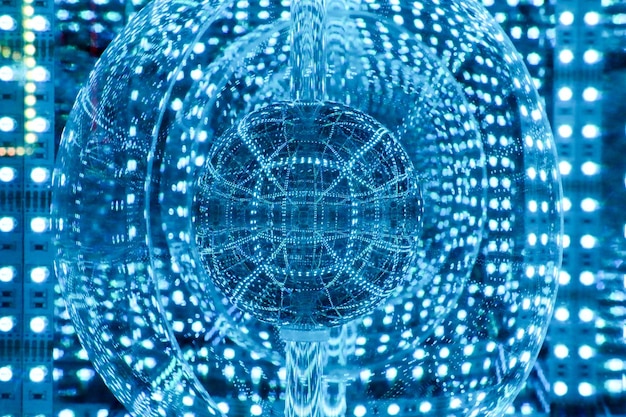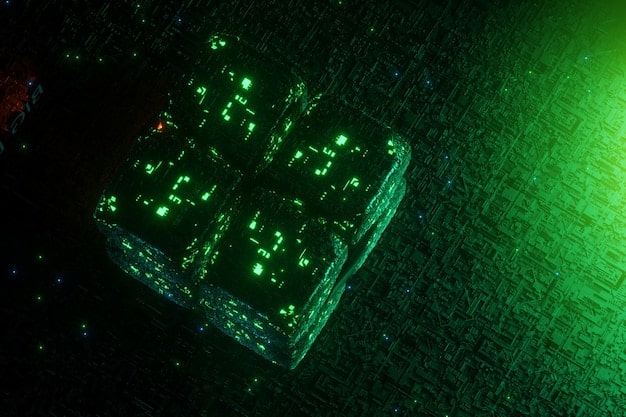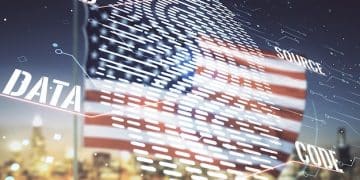Quantum Computing vs. US Cybersecurity: 2025 Threat Forecast

Quantum computing is poised to revolutionize US cybersecurity by 2025, presenting both unprecedented threats to current encryption methods and innovative solutions for enhanced data protection and secure communication protocols.
The advent of quantum computing promises groundbreaking advancements across various sectors, but its potential impact on US cybersecurity by 2025 is a double-edged sword, requiring immediate attention and strategic adaptation.
Understanding the Quantum Computing Revolution
Quantum computing represents a paradigm shift from classical computing, leveraging quantum mechanics principles to perform complex calculations at speeds unattainable by traditional computers. This leap in computational power has profound implications, particularly for cybersecurity, where existing cryptographic methods are vulnerable.
The impending quantum revolution necessitates a comprehensive understanding of its potential impact on US cybersecurity infrastructure. Developing effective strategies to mitigate risks and harness quantum technologies for enhanced security is paramount for maintaining a robust and resilient cyber defense.
How Quantum Computers Differ
Classical computers store information as bits, representing either 0 or 1. Quantum computers, however, use qubits, which can exist in a superposition of both states simultaneously, allowing them to process exponentially more data.
Key Quantum Computing Concepts
Entanglement and superposition are at the heart of quantum computing. These phenomena enable quantum computers to perform calculations in parallel, thereby achieving unprecedented computational speed and efficiency.
- Superposition: Allows qubits to exist in multiple states simultaneously.
- Entanglement: Links two or more qubits in such a way that they are intrinsically connected.
- Quantum algorithms: Specifically designed to leverage quantum mechanics for complex computations.
In conclusion, understanding the foundational concepts of quantum computing is crucial for comprehending its transformative potential and the associated cybersecurity challenges. Preparing for this technological advancement requires a proactive approach to research, development, and strategic planning.
The Looming Threat to Current Encryption Methods
One of the most significant concerns is the ability of quantum computers to break current encryption methods that protect sensitive data across US government, financial, and healthcare sectors. Algorithms such as RSA and ECC, widely used today, are susceptible to attacks by quantum algorithms like Shor’s algorithm.
Specifically, Shor’s algorithm can efficiently factor large numbers, rendering RSA encryption obsolete. The impact of such a vulnerability could be catastrophic, exposing vast amounts of confidential information to malicious actors.

The Impact on RSA and ECC
RSA and Elliptic Curve Cryptography (ECC) are foundational to modern cybersecurity. A quantum-enabled Shor’s algorithm poses an existential threat, capable of rendering these encryption schemes useless.
Quantum Attacks on Key Infrastructure
Critical infrastructure, including power grids, communication networks, and financial systems, rely heavily on robust encryption. Quantum attacks could disrupt these systems, leading to widespread chaos and economic damage.
- Data breaches: Sensitive information stolen from government databases and private companies.
- Financial fraud: Unauthorized access to financial accounts and systems.
- Espionage: Foreign adversaries gaining access to classified information.
In summary, the threat to existing encryption methods posed by quantum computing is significant and cannot be ignored. Developing quantum-resistant cryptographic solutions is essential for safeguarding US cybersecurity interests.
Developing Quantum-Resistant Cryptography
In response to the quantum threat, the cybersecurity community is actively developing quantum-resistant cryptographic algorithms, also known as post-quantum cryptography (PQC). These algorithms are designed to withstand attacks from both classical and quantum computers.
The National Institute of Standards and Technology (NIST) is leading the charge by conducting a multi-year effort to evaluate and standardize PQC algorithms. Several promising candidates are under consideration, offering a pathway to securing data in the quantum era.
NIST’s Post-Quantum Cryptography Standardization Process
NIST’s process involves rigorous evaluation of PQC algorithms, ensuring they meet stringent security and performance requirements. This initiative aims to provide a reliable set of cryptographic tools for the cybersecurity community.
Leading PQC Algorithm Candidates
Several algorithms, including lattice-based cryptography, code-based cryptography, and multivariate cryptography, are considered leading candidates for PQC standardization. Each has unique strengths and weaknesses.
- Lattice-based cryptography: Relies on the difficulty of solving problems on lattices, offering strong security against quantum attacks.
- Code-based cryptography: Based on error-correcting codes, providing a robust and versatile approach to encryption.
- Multivariate cryptography: Uses systems of multivariate polynomial equations that are difficult to solve, even with quantum computers.
To summarize, developing and deploying quantum-resistant cryptography is a critical step toward securing US cybersecurity against quantum threats. Active participation in NIST’s standardization process and collaboration within the cybersecurity community are essential for success.
Quantum Key Distribution (QKD) as a Solution
Quantum Key Distribution (QKD) offers a fundamentally different approach to securing communication channels. Unlike traditional cryptography, QKD leverages the laws of quantum mechanics to ensure secure key exchange.
QKD systems use photons to transmit encryption keys. Any attempt to intercept or eavesdrop on the quantum channel introduces detectable disturbances, alerting the communicating parties to a potential security breach.

How QKD Works
QKD relies on quantum principles to detect eavesdropping attempts. The laws of quantum mechanics ensure that any measurement of the quantum channel alters the state of the qubits, revealing the presence of an attacker.
Benefits of QKD
QKD offers several advantages over classical cryptography, including unconditional security and the ability to detect eavesdropping in real-time. This technology provides a robust defense against quantum attacks.
- Unconditional security: Security is guaranteed by the laws of physics, not computational assumptions.
- Eavesdropping detection: Any attempt to intercept the quantum channel is immediately detectable.
- Secure key exchange: Keys are exchanged securely, even in the presence of adversaries.
In conclusion, Quantum Key Distribution provides a promising solution for securing communication channels against quantum attacks. Its unique capabilities and robust security features make it an essential component of future cybersecurity strategies.
The Role of Quantum-Safe Protocols and Standards
To effectively integrate and deploy quantum-resistant cryptography, the development and adoption of quantum-safe protocols and standards are paramount. These protocols define how cryptographic algorithms are implemented and used in various applications.
Standardization efforts are underway to ensure interoperability and compatibility across different systems and platforms. Establishing clear guidelines and best practices will facilitate the widespread adoption of quantum-safe technologies.
Importance of Standardization
Standardization is critical for ensuring that quantum-resistant cryptographic solutions can be seamlessly integrated into existing cybersecurity infrastructure. This process promotes interoperability and reduces the complexity of deploying new technologies.
Developing Quantum-Safe TLS and VPNs
Transport Layer Security (TLS) and Virtual Private Networks (VPNs) are critical components of online security. Developing quantum-safe versions of these protocols is essential for protecting sensitive communications.
- Quantum-safe TLS: Securing web communications against quantum attacks.
- Quantum-safe VPNs: Protecting network traffic from quantum eavesdropping.
- Integration with existing systems: Ensuring compatibility with current cybersecurity infrastructure.
In summary, the development and adoption of quantum-safe protocols and standards are crucial for the effective integration and deployment of quantum-resistant cryptography. These efforts will pave the way for a more secure and resilient cybersecurity landscape.
Preparing the US Cybersecurity Workforce for the Quantum Era
Addressing the quantum threat requires a skilled and knowledgeable cybersecurity workforce. Investing in education and training programs is essential for preparing professionals to tackle the challenges of quantum computing.
Several initiatives are underway to provide cybersecurity professionals with the necessary expertise to develop, deploy, and maintain quantum-resistant cryptographic solutions. These programs aim to bridge the skills gap and ensure that the US has the talent needed to protect its critical infrastructure.
Education and Training Initiatives
Universities and colleges are incorporating quantum computing and cryptography into their cybersecurity curricula. These educational initiatives are preparing the next generation of cybersecurity professionals.
Developing Quantum-Aware Cybersecurity Professionals
Training programs and certifications are being developed to equip current cybersecurity professionals with the skills needed to manage quantum risks. These initiatives cover a wide range of topics, from quantum mechanics to post-quantum cryptography.
- Quantum cryptography courses: Providing in-depth knowledge of quantum principles and cryptographic applications.
- PQC training programs: Equipping professionals with the skills to implement and deploy quantum-resistant algorithms.
- Hands-on experience: Offering practical training in quantum security tools and techniques.
To conclude, preparing the US cybersecurity workforce for the quantum era is a critical investment in the nation’s security. By providing education and training opportunities, the US can ensure it has the talent needed to protect its critical infrastructure from quantum threats.
Strategic Investments in Quantum Cybersecurity Research and Development
Continued investment in quantum cybersecurity research and development is essential for maintaining a competitive edge and securing US interests. Government agencies, academic institutions, and private companies must collaborate to drive innovation and develop cutting-edge technologies.
Focusing on both defensive and offensive capabilities will enable the US to effectively counter quantum threats and leverage quantum technologies for enhanced cybersecurity. Strategic investments will pave the way for a more secure and resilient cyber future.
Funding Priorities
Prioritizing funding for PQC algorithm development, QKD systems, and quantum-safe protocols is critical. These investments will accelerate the development and deployment of quantum-resistant solutions.
Collaboration and Partnerships
Fostering collaboration between government, academia, and industry is essential for driving innovation and sharing knowledge. These partnerships will facilitate the development of quantum-safe technologies.
- Government-funded research: Supporting basic research in quantum computing and cryptography.
- Academic partnerships: Collaborating with universities to develop cutting-edge technologies.
- Industry collaboration: Working with private companies to deploy quantum-resistant solutions.
In summary, strategic investments in quantum cybersecurity research and development are essential for securing US interests and maintaining a competitive edge. These investments will drive innovation, foster collaboration, and pave the way for a more secure and resilient cyber future.
| Key Point | Brief Description |
|---|---|
| 🔒 Quantum Threat | Quantum computers can break current encryption methods. |
| 🛡️ PQC | Developing quantum-resistant cryptography is essential. |
| 🔑 QKD | Quantum Key Distribution offers secure key exchange. |
| 👨💻 Workforce | Training professionals for the quantum cybersecurity era. |
FAQ
▼
Quantum computing uses quantum mechanics to solve complex problems that are beyond the capability of classical computers. It leverages qubits for processing information efficiently.
▼
Quantum computers can run Shor’s algorithm, which can efficiently break widely used encryption algorithms like RSA and ECC, compromising sensitive data.
▼
Post-quantum cryptography refers to cryptographic algorithms designed to resist attacks from both classical and quantum computers, ensuring long-term data security.
▼
QKD uses quantum mechanics to securely distribute encryption keys. Any attempt to eavesdrop on the key exchange will be detectable, ensuring secure communication.
▼
The US can invest in research and development of PQC, train cybersecurity professionals, and establish quantum-safe protocols and standards to enhance its cyber defenses.
Conclusion
As we approach 2025, the impact of quantum computing on US cybersecurity cannot be overstated. While posing significant threats to current encryption methods, it also offers innovative solutions like PQC and QKD. Proactive measures, strategic investments, and a skilled workforce are essential for navigating this evolving landscape and securing the nation’s cyber future.





